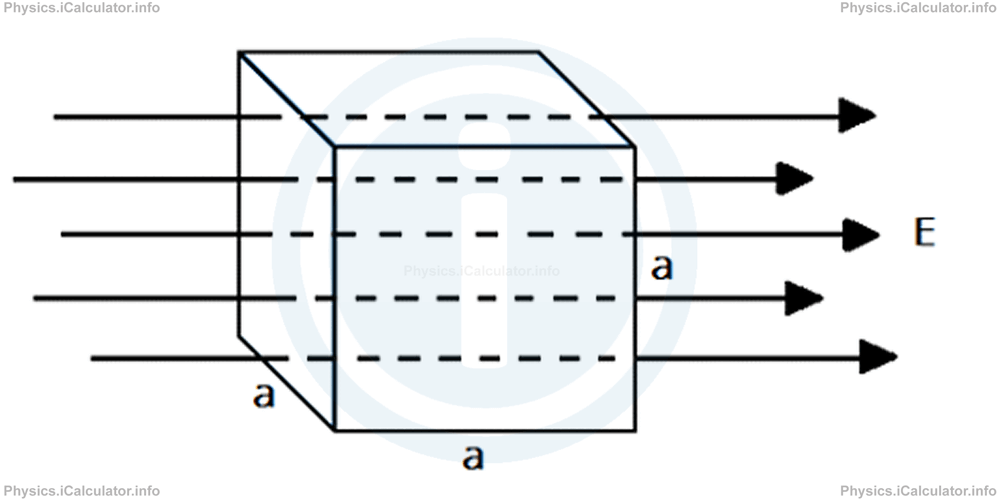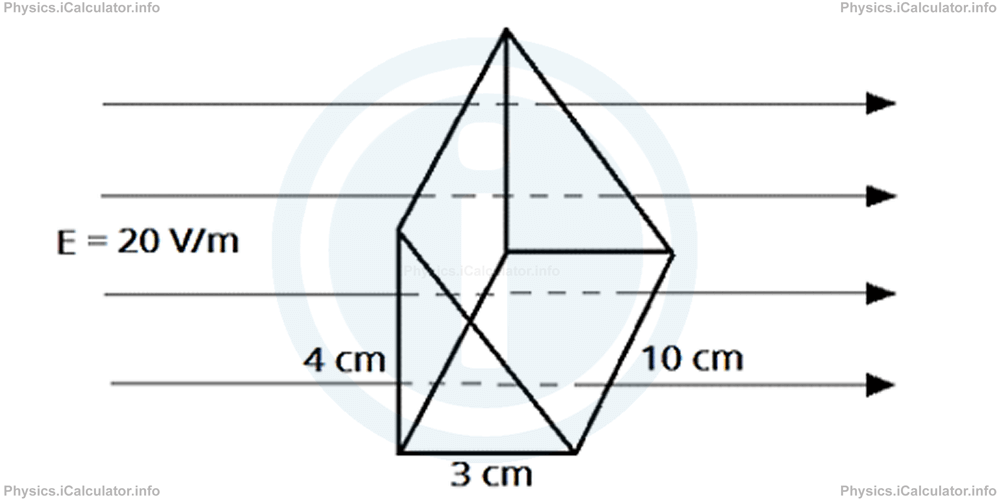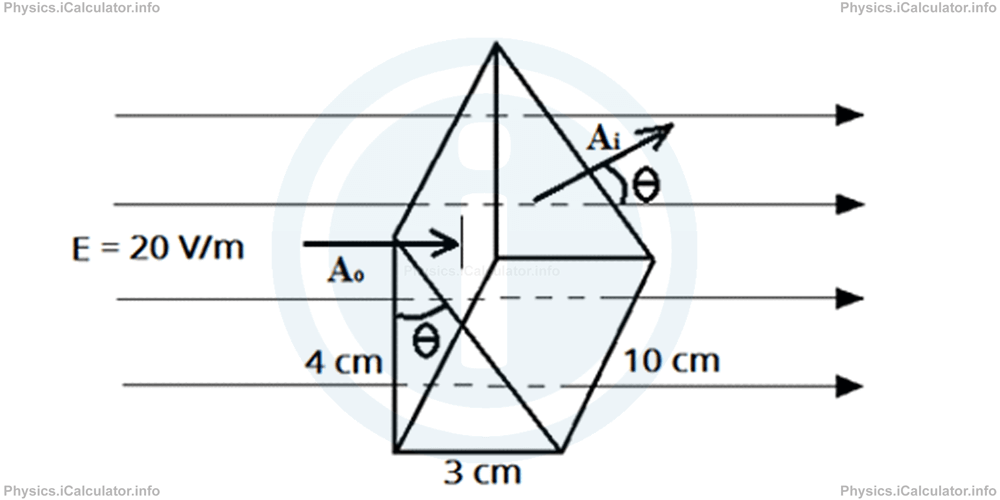Menu
Physics Lesson 14.6.4 - Electric Flux of a Charged Cube
Please provide a rating, it takes seconds and helps us to keep this resource free for all to use
Welcome to our Physics lesson on Electric Flux of a Charged Cube, this is the fourth lesson of our suite of physics lessons covering the topic of Electric Flux. Gauss Law, you can find links to the other lessons within this tutorial and access additional physics learning resources below this lesson.
Electric Flux of a Charged Cube
Let's consider the electric flux across a cube of side length a when it is inserted inside a uniform electric field E. Assume the electric field lines are perpendicular to one of the cube faces.

The four faces parallel to the field have zero flux as no field line crosses them. This is also clear when considering the electric flux formula, in which the cosine between the field lines and the area vectors is zero as they are perpendicular (cos 90° = 0).
From the two remaining faces, it is easy to see that in the left face there is an inwards flux while in the right face the flux is in the outward direction. Therefore, the total flux is zero as the area vectors in these two faces are opposite. This means for one of them the angle must be taken as zero (outward) while for the other face (inward) we must take the angle as 180°. Therefore, we obtain for the total electric flux flowing through the cube
= |E⃗ | × |A⃗ | × cos 1800 +|E⃗ | × |A⃗ | × cos 00
= |E⃗ | × |A⃗ | × (-1) + |E⃗ | × |A⃗ | × 1
= -|E⃗ | × |A⃗ | + |E⃗ | × |A⃗ |
= 0
In general, when electric field is at angle θ to the area vector, we obtain for the total electric flux flowing through a cube
= |E⃗ | × |A⃗ | × cos θ + |E⃗ | × |A⃗ | × cos (180 - θ)
= 0
Example 4
What is the net electric flux for the triangular prism shown in the figure if the prism is placed inside a 20 V/m uniform electric field whose lines are horizontal?

Solution 4
Electric field lines cross only two of the three rectangular faces of prism, because the bottom face and the two bases are parallel to the electric field lines.
First, we find the missing side of the prism using the Pythagorean Theorem. We have
Thus, c = √25 = 5 cm.
The electric flux crossing the 4 cm × 10 cm face is in the inward direction, so we take it as negative, while that on the 5 cm × 10 cm face is in the outward direction, so we take it as positive.
The area vector of the left face is in the opposite direction of the electric field vector, so the angle between them is 180° (cos 180° = - 1). In addition, the magnitude of area vector on the left side (at the input) is
= 40 cm2
= 4 × 10-3 m2
Therefore, the inward flux is
= 20 V/m × 4 × 10-3 m2 × (-1)
= -8 × 10-2 V × m
= -0.08 V × m
The magnitude of area vector for the right face of prism (output) is
= 50 cm2
= 5 × 10-3 m2
Furthermore, the electric field lines are not in the direction of the area vector but they form an angle θ equal to that of the upper vertex (the sides are respectively perpendicular) as shown in the figure.

We need the cosine of the angle θ to work out the flux, i.e.
= 3 cm/5 cm
= 0.6
Therefore, the outward flux is
= 20 V/m × 5 × 10-3 m2 × 0.6
= 6 × 10-2 V × m
= 0.06 V × m
Hence, the net electric flux flowing through the prism is
= -0.08 V × m + 0.06 V × m
= -0.02 V/m
You have reached the end of Physics lesson 14.6.4 Electric Flux of a Charged Cube. There are 4 lessons in this physics tutorial covering Electric Flux. Gauss Law, you can access all the lessons from this tutorial below.
More Electric Flux. Gauss Law Lessons and Learning Resources
Whats next?
Enjoy the "Electric Flux of a Charged Cube" physics lesson? People who liked the "Electric Flux. Gauss Law lesson found the following resources useful:
- Charged Cube Feedback. Helps other - Leave a rating for this charged cube (see below)
- Electrostatics Physics tutorial: Electric Flux. Gauss Law. Read the Electric Flux. Gauss Law physics tutorial and build your physics knowledge of Electrostatics
- Electrostatics Revision Notes: Electric Flux. Gauss Law. Print the notes so you can revise the key points covered in the physics tutorial for Electric Flux. Gauss Law
- Electrostatics Practice Questions: Electric Flux. Gauss Law. Test and improve your knowledge of Electric Flux. Gauss Law with example questins and answers
- Check your calculations for Electrostatics questions with our excellent Electrostatics calculators which contain full equations and calculations clearly displayed line by line. See the Electrostatics Calculators by iCalculator™ below.
- Continuing learning electrostatics - read our next physics tutorial: Capacitance and Capacitors
Help others Learning Physics just like you
Please provide a rating, it takes seconds and helps us to keep this resource free for all to use
We hope you found this Physics lesson "Electric Flux. Gauss Law" useful. If you did it would be great if you could spare the time to rate this physics lesson (simply click on the number of stars that match your assessment of this physics learning aide) and/or share on social media, this helps us identify popular tutorials and calculators and expand our free learning resources to support our users around the world have free access to expand their knowledge of physics and other disciplines.